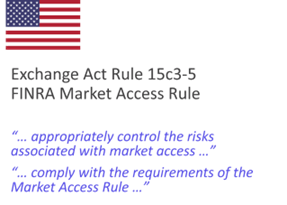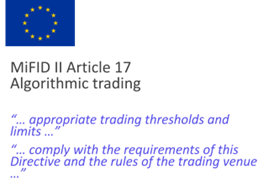Watch the video short here.
In the world of electronic trading, regulatory compliance isn't solely a legal requirement—it's a vital safeguard for market integrity. Our recent webinar, "Trading Safeguards: Enhancing Security with OMS Risk Controls," explored how regulatory frameworks and Order Management Systems (OMS) work together to protect firms, customers, and the broader market. This article distills key insights from that webinar discussion, offering a roadmap for navigating the complexities of financial market regulations.
The Regulatory Landscape
Two major regulations shape the compliance environment for electronic trading: FINRA Rule 15c3-5 in the United States and MiFID II Article 17 in the European Union.

FINRA Market Access Rule (FINRA Rule 15c3-5)
FINRA Rule 15c3-5, known as the Market Access Rule, requires broker-dealers to implement pre-trade risk controls to block potentially harmful orders before they reach the market. The rule emphasizes preventing "naked access," where participants might trade without adequate risk controls. Firms must establish systems to automatically block or delay risky orders, including checks for credit, capital thresholds, and position limits. Regular testing and record-keeping are required to ensure compliance. By enforcing these measures, the rule protects market integrity and ensures the stability of the financial system.

MiFID II Article 17
MiFID II Article 17 regulates algorithmic trading in Europe by requiring firms to implement risk management systems, including real-time monitoring and automated controls to prevent erroneous orders. Firms must have mechanisms to continuously monitor and suspend trading if necessary, using "kill switches" to stop trading in case of abnormalities. Regular stress testing and comprehensive record-keeping of trading activities and algorithms are also required to ensure transparency and oversight. These stringent standards protect market integrity, prevent manipulation, and foster investor confidence by ensuring a fair trading environment.
Implementing Effective Risk Controls
Risk controls are the foundation for maintaining a secure and compliant trading environment, especially in the face of increasing regulatory scrutiny. Effective risk control measures begin with a thorough assessment of the firm's trading activities and their associated risks. This involves setting up automated systems within the OMS to monitor and manage these risks in real time. Critical components of this setup include the establishment of trading thresholds, credit limits, and automated checks that can flag or block orders that do not comply with predefined criteria.
At the start of the implementation process is the integration of pre-trade risk controls. These controls are designed to evaluate orders before they reach the market, ensuring they meet all necessary conditions, such as price limits, position sizes, and compliance with internal policies and regulatory requirements. For example, a pre-trade check might verify that an order's price does not deviate excessively from the current market value, preventing "fat finger" errors that could lead to unintended market impact. Similarly, size checks can ensure that the volume of an order does not exceed the trader's authorized limits or the firm's risk appetite.
At-trade controls provide real-time monitoring during the execution of trades, allowing for immediate intervention if an anomaly is detected. These controls can trigger alerts or halt trading activities if certain thresholds are breached, such as unusual trading volumes or patterns that may indicate market abuse or technical errors. Post-trade controls, on the other hand, focus on reconciliation and verification processes to ensure that all executed trades are accurately recorded and settled. This includes cross-checking trade details against the firm's internal records and external market data to identify and resolve discrepancies.
These controls should be supported by sophisticated data analytics capabilities, allowing firms to generate detailed reports and conduct thorough reviews of their risk management practices.
Demonstrating Compliance
Demonstrating compliance with regulatory standards is a crucial aspect of operating within the financial markets, especially as regulations become increasingly stringent. For firms, it is not enough to merely have risk controls in place; they must also be able to prove that these controls are adequate and consistently applied. This requirement involves maintaining comprehensive records and providing clear, detailed documentation that outlines the firm's risk management processes. These records are reviewed during regulatory audits, where firms must showcase their adherence to laws such as FINRA Rule 15c3-5 and MiFID II Article 17.
Having the right OMS is critical in this demonstration process. The OMS can generate detailed logs of all trading activities, including activating risk controls, the parameters checked, and any actions taken when an order triggers an alert. These logs are verifiable trails that regulators can review to ensure the firm complies with all necessary regulations. Additionally, the OMS should be capable of producing real-time reports and historical data analyses, providing a transparent view of the firm's compliance status over time.
Another important aspect of demonstrating compliance is conducting and documenting regular risk control system testing. Firms must often test their systems under various market conditions to ensure they can handle different scenarios, such as market volatility or sudden surges in trading volume. The results of these tests and any subsequent adjustments made to the risk management framework must be meticulously recorded and made available for regulatory review. This proactive approach helps firms stay compliant and identifies potential weaknesses in their systems before they can be exploited or cause market disruptions.
Finally, firms must have a clear and documented policy for responding to compliance issues when they arise. This includes a predefined process for investigating potential breaches, reporting incidents to the appropriate regulatory bodies, and implementing corrective measures to prevent future occurrences. By adopting a transparent compliance framework, firms can build trust with regulators, clients, and other market participants. This trust is invaluable, as it reinforces the firm's reputation as a reliable and responsible market player, ultimately supporting its long-term success and stability in the financial markets.
Universal Need for Compliance
While regulations may be vary by region, they reflect a global trend towards stricter oversight of electronic trading. Firms operating across multiple jurisdictions face the challenge of adapting to varied regulatory requirements while maintaining operational consistency. This universal requirement for compliance stems from the interconnected nature of global markets, where one participant's actions can have far-reaching consequences, impacting markets and investors worldwide.
Regulatory bodies in different regions, such as the Securities and Exchange Commission (SEC) in the United States, the Financial Conduct Authority (FCA) in the United Kingdom, and the European Securities and Markets Authority (ESMA) in the European Union have established processes to govern market activities. These frameworks, while region-specific, often share common goals: protecting investors, maintaining fair and orderly markets, and preventing market abuse. Regulations like the U.S. FINRA Rule 15c3-5 and the EU's MiFID II illustrate this shared commitment by enforcing stringent risk management and transparency standards. Firms operating in these jurisdictions must adhere to the requirements, regardless of where they are based.
In order to keep pace with regulatory requirements, firms should adopt advanced compliance solutions, such as those integrated within the OMS, to monitor and manage compliance in real-time. These systems can automate the enforcement of regulatory rules, generate necessary reports, and maintain detailed records, all of which are critical for demonstrating compliance during audits or investigations.
The Strategic Value of Risk Management
Robust risk management is essential for safeguarding a firm's assets, protecting client interests, and maintaining market stability. The potential for errors, market abuse, and systemic risks has increased significantly in an environment characterized by rapid technological advancements and complex trading strategies. Robust risk management frameworks are crucial in identifying, assessing, and mitigating these risks.
Effective risk management is not solely about preventing losses but also about building resilience within the organization. By proactively managing risks, firms can better navigate market volatility, regulatory changes, and other external pressures. This proactive stance fosters confidence among investors, regulators, and other stakeholders, who view a firm’s commitment to robust risk management as a sign of stability and reliability. By viewing risk management as a strategic asset rather than a regulatory burden, firms can turn compliance into a competitive advantage.
Conclusion
As electronic trading continues to evolve, so too will the regulatory frameworks governing it. Firms that invest in flexible, comprehensive risk management systems will be well-positioned to adapt to these changes, protecting themselves and their clients while contributing to overall market stability.
We encourage you to watch the full webinar for a deeper dive into these crucial topics. Effective risk management is an ongoing process, not a one-time implementation, so be sure to stay informed about regulatory changes, regularly review and update your risk controls, and don't hesitate to seek expert advice when needed.
For those interested in exploring how advanced OMS solutions can support your risk management efforts, our team is available for personalized consultations. Contact us at [email protected] to learn more or schedule a demo.
Links and Contact Information
We look forward to learning more about your trading needs.

Market Asymmetry Before It Moves You
In today’s markets, sharp price moves rarely come out of nowhere. They build quietly ...

Sterling OMS 360: A New Era in OMS
The newly launched OMS provides the only real-time margin and multi-asset capability during ...

The Intersection of Pre- and Post-Trade Risk
Effective risk management is paramount in today's fast-evolving financial landscape. Firms ...

Sterling Trading Tech wins Best Listed Derivatives Trading Platform in APAC - Recognized at the A-Team Capital Markets Technology Awards APAC 2025
Sterling Trading Tech (Sterling), a leading provider of professional trading technology ...